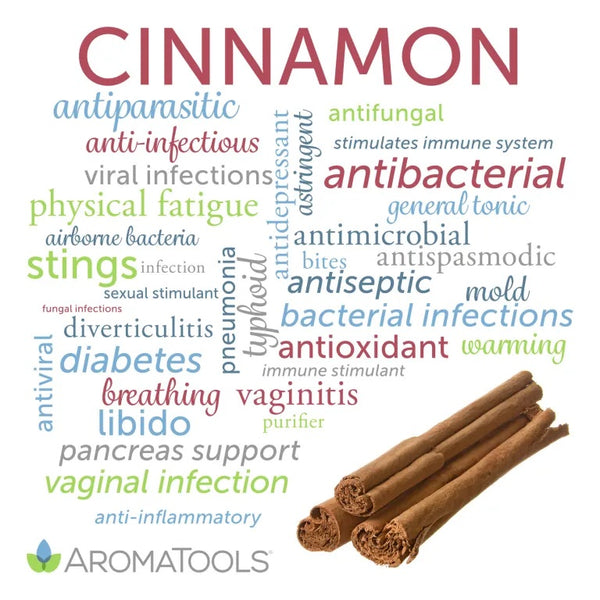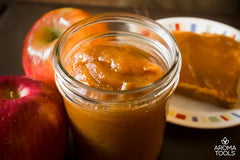Your Cart is Empty
Shop by Category
Essential Oil Spotlight: Cinnamon

Cinnamon essential oil (Cinnamomum zeylanicum) is steam-distilled from the bark of the tree. It contains antibacterial, antidepressant, antifungal, anti-infectious (intestinal, urinary), anti-inflammatory, antimicrobial, antioxidant, antiparasitic, antiseptic, antispasmodic (light), antiviral, astringent, immune-stimulant, purifying, sexual-stimulant, and warming properties. It also enhances the action and activity of other oils.
Cinnamon essential oil is commonly used for airborne bacteria, bacterial infections, bites/stings, breathing, diabetes, diverticulitis, fungal infections, immune system (stimulates), infection, libido (low), mold, pancreas support, physical fatigue, pneumonia, typhoid, vaginal infection, vaginitis, viral infections, and warming the body.
Historically, this most ancient of spices was included in just about every prescription issued in ancient China. It was regarded as a tranquilizer, tonic, and stomachic and as being good for depression and a weak heart.
This oil may be beneficial for circulation, colds, coughs, digestion, exhaustion, flu, infections, rheumatism, and warts. Cinnamon oil fights viral and infectious diseases, and testing has yet to find a virus, bacteria, or fungus that can survive in its presence.
Applications of Cinnamon Essential Oil and Safety Data
Cinnamon essential oil is one of the strongest essential oils, and care should be taken when using it.
Topical Application: Before applying cinnamon oil topically, make sure to dilute it 1:3 (1 drop essential oil to at least 3 drops carrier oil). Please note that repeated use of cinnamon essential oil can result in extreme contact sensitization, so make sure to dilute well, avoid when pregnant, and frequently give your body a break in between uses.
Aromatic Application: When diffusing cinnamon essential oil, be careful to not inhale directly from the diffuser, as it may irritate the nasal membranes.
Internal Application: Cinnamon essential oil can be used in cooking, but make sure to start with only a toothpick and add more if needed.
5 Ways To Use Cinnamon Essential Oil
1. Diffuse
Try this blend in your diffuser to increase your mental alertness:

Here are a few other diffuser blends that use cinnamon essential oil:



2. Use in a Romantic Massage Oil
Because cinnamon essential oil is known to be an aphrodisiac and is a warming oil, it makes a great addition to a romantic massage oil. Here is a great recipe to help you and your spouse enjoy an intimate massage together:
|
Romantic Massage Oil: 5 drops ylang ylang 1 drop cinnamon 1 Tbsp. (15 ml) carrier oil such as Fractionated Coconut Oil, Sweet Almond Oil, or Jojoba Oil. |
3. Add to a Breath-Freshening Spray
Try adding 2–3 drops each of cinnamon and orange essential oil to this Essential Oil Breath Spray recipe.
4. Add to Cooking Recipes
Cinnamon essential oil is great to add to any of your favorite recipes. We had a difficult time picking from our recipes that use cinnamon essential oil, but here are some of our favorites:






5. Protect Your Plants with This Gardening Spray
Keep birds and bugs from eating your plants with this garden spray.
Protective Gardening Spray
Servings: Yield 1 gallon (about 4 liters) | Time: 5 minutes | Difficulty: Easy
Ingredients:
- 15 drops Natural Essential Oil Emulsifier
- 8 drops cinnamon essential oil
- 7 drops peppermint essential oil
- 1/4 tsp. (1.5 ml) biodegradable dish soap
- 1 gallon (4 liters) water
- 16 oz. Glass Bottles and Trigger Spray Tops
Instructions:
- To a small glass bowl, add the emulsifier, essential oils, and dish soap in order; gently stir after adding each ingredient. Pour a little (up to 1 cup or 250 ml) water into the bowl, and stir to combine.
- Pour mixture into a gallon-sized (4-liter) water jug (mostly full of water). Place the cap on, and carefully shake to combine. Pour mixture into your 16 oz. glass spray bottles.
- To use, spray the tops and bottoms of the plant leaves. It is best to spray on a cloudy day or in the evening so the sun and cinnamon essential oil combination doesn’t burn the plants. Apply every couple weeks or as needed. Wait 2–3 days after spraying to harvest any food.
To learn more about cinnamon essential oil, see the book Modern Essentials : A Contemporary Guide to the Therapeutic Use of Essential Oils.
: A Contemporary Guide to the Therapeutic Use of Essential Oils.
Sources: Modern Essentials : A Contemporary Guide to the Therapeutic Use of Essential Oils, 8th Edition, pp. 48–49; 329–30.
: A Contemporary Guide to the Therapeutic Use of Essential Oils, 8th Edition, pp. 48–49; 329–30.
Leave a comment
Comments will be approved before showing up.
Also in Essential Ideas by AromaTools

Lavender Bubble Bath Salts
bath Body Care Recipes castile soap Epsom salt Essential Ideas Gift Ideas jojoba oil lavender skin care
If you’re looking for a fun new twist on your traditional bath salt recipe, this is the one for you! By combining epsom salt with castile soap and jojoba oil, your bath is taken to a new level.
Read More
“Essentially You” Shampoo & Conditioner
Body Care Recipes castile soap conditioner Essential Ideas essential oils hair care shampoo sweet almond oil vegetable glycerin vinegar
Customized hair care is a booming business on the internet. Just how is it done? Basically, an online quiz—about hair type and health, desired care outcomes, and perhaps lifestyle and environment—determines each individual’s formulas. Naturally, these personalized products are much …
Read More
Luxurious Bath Bombs
bath Body Care Recipes Citric Acid Epsom salt Essential Ideas essential oils fractionated coconut oil relax skin care sweet almond oil witch hazel
Baths can be relaxing or energizing depending on the time of day, the temperature of the water, and the essential oils you use. These bath bombs will take an average bath to the next level and make it luxurious! You …
Read More Essential Ideas and More
We love sharing tips and tricks on how to safely and effectively use essential oils. Join in on the conversation!
Popular Articles This Month
10 Diffuser Blends for the Road
Essential Oils for Heart Health & Cardiovascular Support
Lighten Your Hair Naturally with Essential Oils
Essential Oil Gummy Candies for Immune Support
Essential Oil Spotlight: Blue Lotus
Men's Cologne with Essential Oils
The Art of Roller Bottle Blending
Keys to Successful Essential Oil Classes (Including 50+ Class Ideas)
Get recipes & ideas delivered to your inbox
Sign up for our newsletter to learn about releases, exclusive deals and more!







